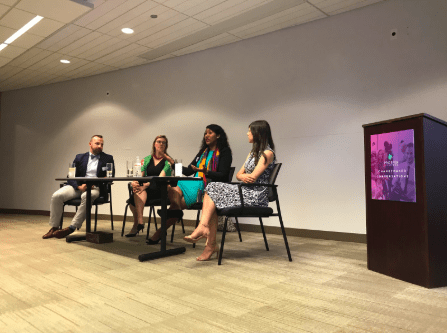Imagine a nonprofit sector where each organization has a culture centered around marketing and communications. We think it can be done.
That was the topic of our recent Changemaker Conversation.
The panel for June’s Changemaker Conversations included Dorri McWhorter, CEO of YWCA, Elisabeth Majeda, Director of Marketing at Chicago Symphony Orchestra and John Williams, Operations and Communications Manager at the Irving Harris Foundation. These panelists brought their candidness, challenges and solutions to the table as they addressed cultural shifts they’re making in order to make marketing and communications a priority at their nonprofits.
Here are some of the most significant insights our panelists shared.
Align all of your stakeholders around the importance of a marketing budget
Prosper has often emphasized the value of giving stakeholders the tools they need to talk about your organization and become effective brand advocates. But before you can even begin to do that, you have to create a cultural foundation for marketing.
Stakeholder alignment around the importance of a sufficient marketing and communications budget is the first step in establishing that culture. Many nonprofits simply don’t believe they have the resources for a sufficient marketing budget. But, if you want to be top of mind for donors, reaching them and showcasing your organization’s unique qualities is necessary for generating revenue and donations. Your stakeholders need to understand that investing in effective marketing can lead to brand recognition, more donations and a higher level of impact on your mission.
One of our panelists, John Williams, began working for the Irving Harris Foundation before they even had a website. For him, a cultural shift toward stronger communications began with the foundation’s leadership. The board, CEO and Executive Director all had to be aligned around the recognition that marketing needed a budget. By setting this precedent and expanding the budget, the organization equipped its stakeholders with the tools they needed to become effective brand advocates.
“That culture had to be intentionally created,” Williams said. “Everyone is a communicator for the organization. Everyone has to be singing from the same song sheet.”

Ensure your marketing and communications culture furthers diversity, equity and inclusion
The nonprofit sector has never before been so intentional about how it addresses diversity, equity and inclusion. Today, most nonprofits have policies that address DEI in the workplace as it relates to recruitment, retention and employee advancement. But DEI isn’t something that only your HR department should contribute to. A marketing and communications culture that addresses DEI can play a huge role in advancing (or harming) your DEI initiatives.
Dorri McWhorter sees nonprofit marketing as a catalyst for driving social change and improving DEI across all sectors. She believes nonprofits need to start asking themselves the tough questions and work together to answer them.
“How do we engage everyone in the world?” McWhorter asked. “How do we create the appropriate business model that accelerates social impact and DEI?”
Fight to get marketing a seat at the leadership table
There are many misconceptions about nonprofit marketing, and if you let your leadership team, employees or board believe them, your marketing agenda will fall woefully behind. Marketing is critical for achieving your strategic goals and advancing your organization’s vision.
When Elisabeth Majeda started working with the Chicago Symphony Orchestra, marketing was tactical and seasonal. She lobbied to get marketing a seat at the table and successfully made her case that the marketing team needs to be in the loop in as much as possible to craft stories and messages that resonate with their audience.
“We need to understand the context in order to tell the stories and recognize the arch of the story,” Majeda said. “Unless we’re at the table, we miss out on that and default to tactical strategies.”
Give your marketing team a chance to work proactively, as opposed to reactively, and reap the benefits.
It’s time to strengthen your nonprofit’s marketing and communications culture
We can all benefit from ensuring marketing and communications get the budget they deserve, positioning marketing to advance DEI and lobbying to ensure marketing has a seat at the leadership table. Building a marketing culture will not only make you more effective in your job, it will also position your nonprofit for greater mission impact.
“We have a big role to play in the social sector,” Williams said. “We have a lot of power when we stand together to make that change.”
If you need more advice on reshaping your nonprofit’s marketing and communications culture, read Prosper Strategies’ Nonprofit Marketing Manifesto.